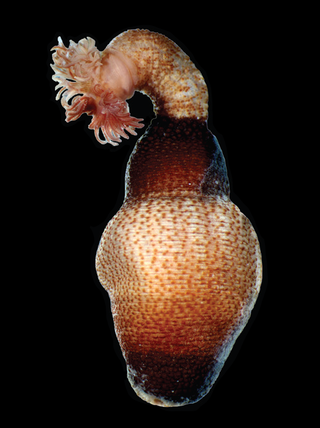
The Sipuncula or Sipunculida is a class containing about 162 species of unsegmented marine annelid worms. Sipuncula was once considered a phylum, but was demoted to a class of Annelida, based on recent molecular work.

Nemertea is a phylum of animals also known as ribbon worms or proboscis worms, consisting of about 1300 known species. Most ribbon worms are very slim, usually only a few millimeters wide, although a few have relatively short but wide bodies. Many have patterns of yellow, orange, red and green coloration. The foregut, stomach and intestine run a little below the midline of the body, the anus is at the tip of the tail, and the mouth is under the front. A little above the gut is the rhynchocoel, a cavity which mostly runs above the midline and ends a little short of the rear of the body. All species have a proboscis which lies in the rhynchocoel when inactive but everts to emerge just above the mouth to capture the animal's prey with venom. A highly extensible muscle in the back of the rhynchocoel pulls the proboscis in when an attack ends. A few species with stubby bodies filter feed and have suckers at the front and back ends, with which they attach to a host.

Priapulida, sometimes referred to as penis worms, is a phylum of unsegmented marine worms. The name of the phylum relates to the Greek god of fertility, because their general shape and their extensible spiny introvert (eversible) proboscis may resemble the shape of a human penis. They live in the mud and in comparatively shallow waters up to 90 metres (295 ft) deep. Some species show a remarkable tolerance for hydrogen sulfide, anoxia and low salinity. Halicryptus spinulosus appears to prefer brackish shallow waters. They can be quite abundant in some areas. In an Alaskan bay as many as 85 adult individuals of Priapulus caudatus per square meter has been recorded, while the density of its larvae can be as high as 58,000 per square meter.

Golfingia vulgaris is a marine invertebrate belonging to the phylum Sipuncula, the peanut worms. It is a cylindrical, unsegmented worm with a crown of tentacles around the mouth. It lives in burrows in shallow seas in various parts of the world.

Scleroplax is a genus of crabs in the family Pinnotheridae.

Aspidosiphonidae is a family of peanut worms. It is the only family in the monotypic order Aspidosiphonida, which is in the class Phascolosomatidea.

Phascolosomatidea is a subclass of the class Sipuncula, the peanut worms, containing two orders:-

Bacterial taxonomy is subfield of taxonomy devoted to the classification of bacteria specimens into taxonomic ranks.
Onchnesoma is one of the two genera that constitute the family Phascolionidae of Phylum Sipuncula, described by Koren and Danielssen established in 1873 as the type species to Onchnesoma steenstrupii.

Antillesoma is a genus of peanut worms. The genus belongs to the family Phascolosomatidae. Antillesoma was described in 1973 by Stephen and Edmonds.

Antillesoma antillarum is the type species of the peanut worm genus Antillesoma. The genus belongs to the family Phascolosomatidae.
The Platyproteum are a genus of parasitic alveolates in the phylum Apicomplexa. Species in this genus infect marine invertebrates.

The annelids, also known as the segmented worms, are a large phylum, with over 22,000 extant species including ragworms, earthworms, and leeches. The species exist in and have adapted to various ecologies – some in marine environments as distinct as tidal zones and hydrothermal vents, others in fresh water, and yet others in moist terrestrial environments.
Nephasoma minutum is a marine invertebrate of the phylum Sipuncula, commonly known as peanut worms because of their shape when contracted. It is a cylindrical, unsegmented worm with a crown of tentacles around the mouth. These worms live in crevices in the rocks or in burrows in shallow water in Western Europe, and the eastern United States.
Nephasoma rimicola is a marine invertebrate belonging to the phylum Sipuncula, the peanut worms. This worm occurs in the northeastern Atlantic Ocean.
Aspidosiphon elegans is a species of unsegmented benthic marine worm in the phylum Sipuncula, the peanut worms. It is a bioeroding species and burrows into limestone rocks, stones and corals. It occurs in the western Indo-Pacific region, the Red Sea, and the tropical western Atlantic Ocean, and is invasive in the eastern Mediterranean Sea.

Sipunculus robustus is a species of unsegmented benthic marine worm in the phylum Sipuncula, the peanut worms.
Themiste cymodoceae is a species of unsegmented benthic marine worm in the phylum Sipuncula, the peanut worms. It is native to shallow waters around Australia and in the South China Sea where it lives in a cavity it creates among seagrass roots and in empty oyster shells.

Themiste pyroides is a species of unsegmented benthic marine worm in the phylum Sipuncula, the peanut worms. It occurs in the intertidal zone and shallow water in the western Atlantic Ocean and the northeastern Pacific Ocean. It lives in crevices and under rocks, extending its "crown" of branching tentacles into the surrounding water to feed.
Thysanocardia procera is a marine invertebrate belonging to the phylum Sipuncula, the peanut worms. It is a cylindrical, unsegmented worm with a crown of tentacles around the mouth. It is native to shallow seas in the northeastern Atlantic Ocean.











